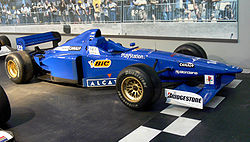Prost JS45
 |
|||||||||
| Category | Formula One | ||||||||
|---|---|---|---|---|---|---|---|---|---|
| Constructor | Prost | ||||||||
| Designer(s) | Loïc Bigois | ||||||||
| Predecessor | Ligier JS43 | ||||||||
| Successor | AP01 | ||||||||
| Technical specifications | |||||||||
| Chassis | carbon-fibre and honeycomb composite structure | ||||||||
| Suspension (front) | double wishbones, pushrod, twin or triple damper | ||||||||
| Suspension (rear) | double wishbones, pushrod, twin damper | ||||||||
| Engine | Mugen Honda MF301HA & MF301HB 72-degree V10s | ||||||||
| Transmission | Prost six-speed transverse semi-automatic | ||||||||
| Fuel | Elf | ||||||||
| Tyres | Bridgestone | ||||||||
| Competition history | |||||||||
| Notable entrants | Prost Gauloises Blondes | ||||||||
| Notable drivers | 14. 14. 15. |
||||||||
| Debut | 1997 Australian Grand Prix | ||||||||
|
|||||||||
| Constructors' Championships | 0 | ||||||||
| Drivers' Championships | 0 | ||||||||
The Prost JS45 was the Formula One racing car with which the Prost team competed in the 1997 Formula One season, and the first Prost-badged car following Alain Prost's acquisition of Ligier in February 1997.
The acquisition of Ligier from Flavio Briatore by Prost, and its subsequent renaming after him, marked the end of the Ligier name in F1 after involvement in the sport since 1976. However, the car had been designed and built beforehand, and so retained its Ligier designation of JS45. Also retained were Mugen Honda engines and Gauloises sponsorship, though the team opted for Bridgestone tyres in the Japanese's company's first year of F1.
The original lead driver was Olivier Panis, who had driven for Ligier since 1994, while in the second seat Prost signed Japanese rookie Shinji Nakano, largely due to pressure from Mugen.
In the first six races of the season, the car proved extremely promising. The problems of braking and pitch sensitivity with the previous year's Ligier JS43 had been largely solved, and this, allied with Panis' skill and the durability of the Bridgestones, enabled the French driver to finish fifth in Australia, third in Brazil, fourth in Monaco and then second in Spain, just six seconds behind eventual World Champion Jacques Villeneuve. These results put him third in the Drivers' Championship, and after the Spanish Grand Prix Villeneuve said that he regarded Panis as one of his main threats for the rest of the season.
However, a suspected suspension failure or puncture caused Panis to crash heavily into a concrete wall at the very next race in Canada, breaking both his legs and putting him out of action for the next seven Grands Prix. Nonetheless, the car remained competitive due to Panis' replacement Jarno Trulli, who had been recruited from Minardi. Trulli finished fourth in Germany before leading the first half of the Austrian Grand Prix after qualifying third, and these achievements impressed Prost enough for him to sign the Italian full-time for 1998. Panis returned for the final three races of the season and picked up one final point for sixth in his first race back, at the Nürburgring.
...
Wikipedia
